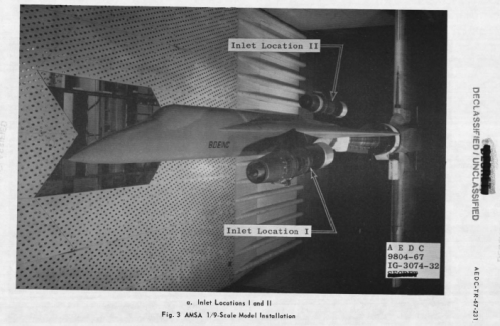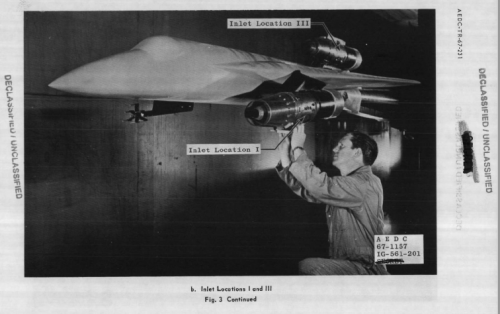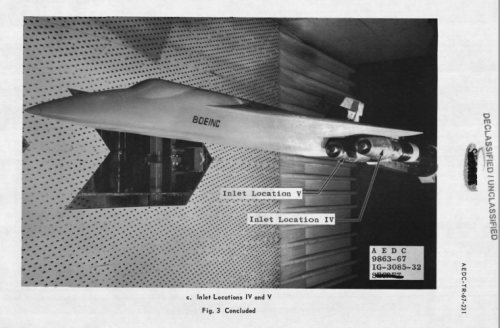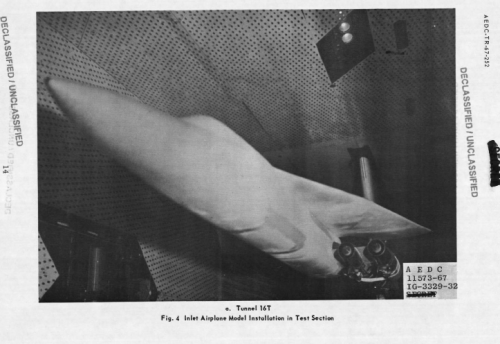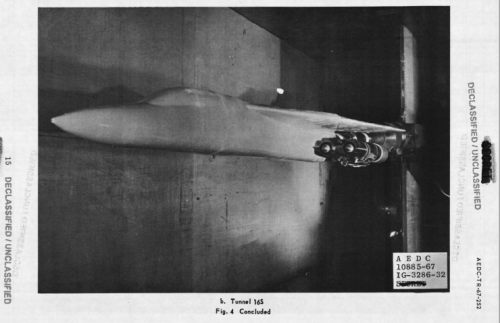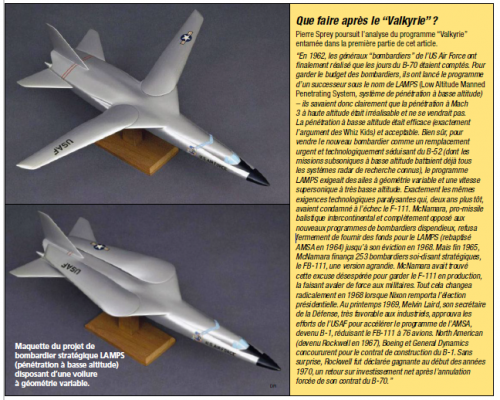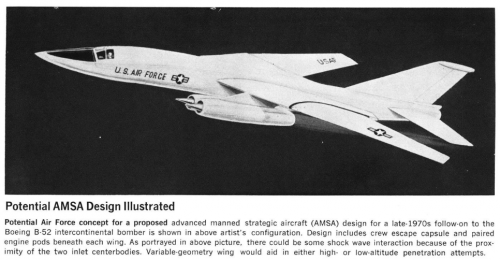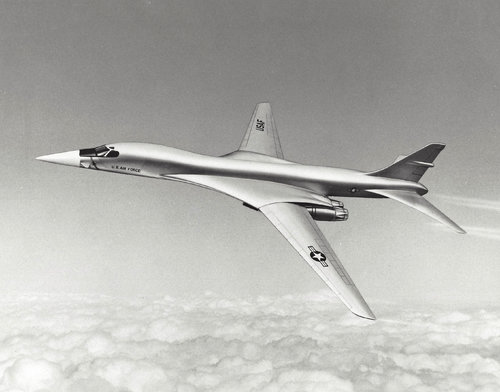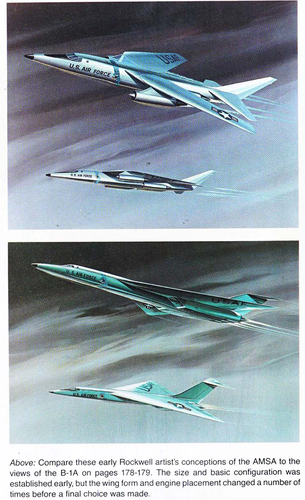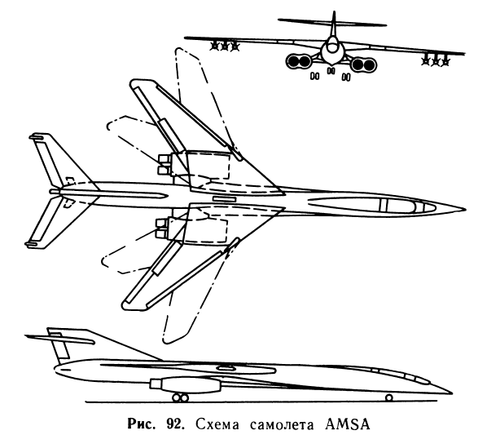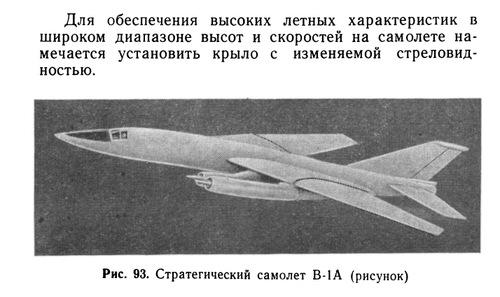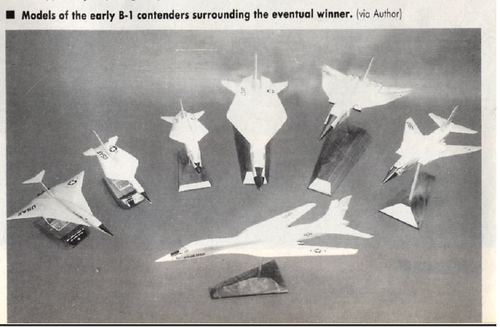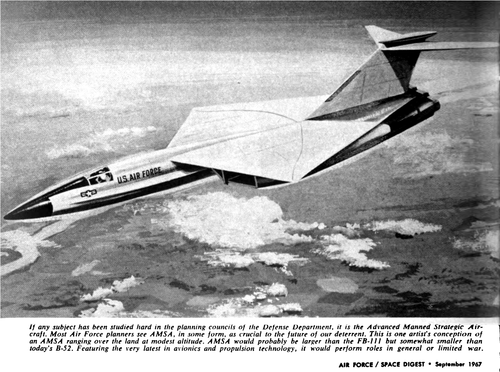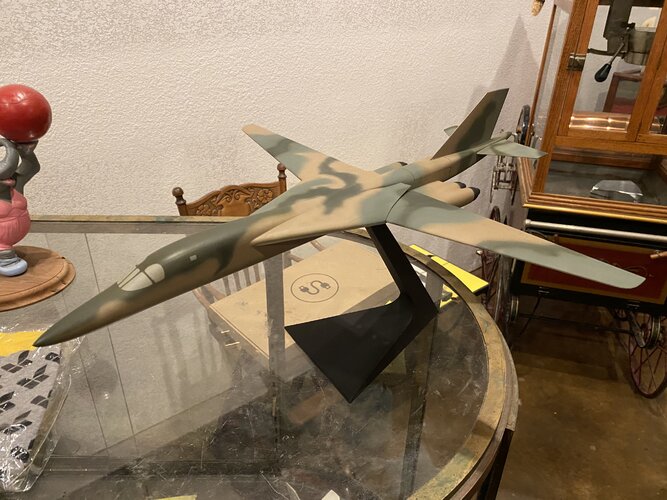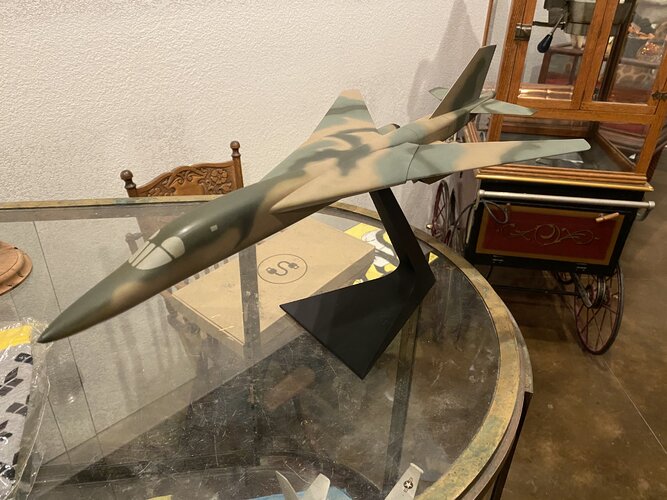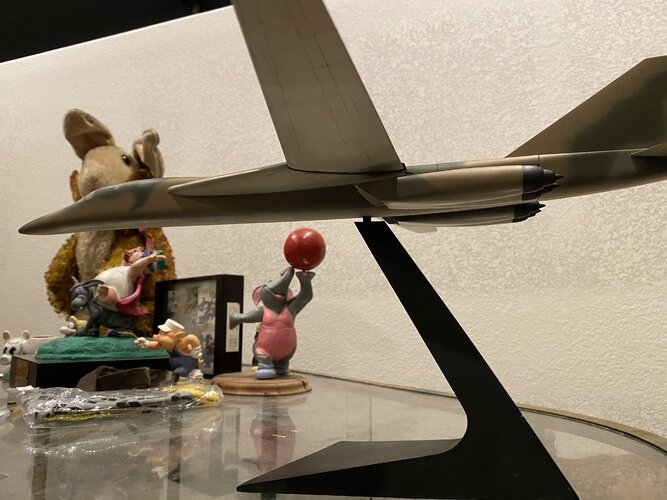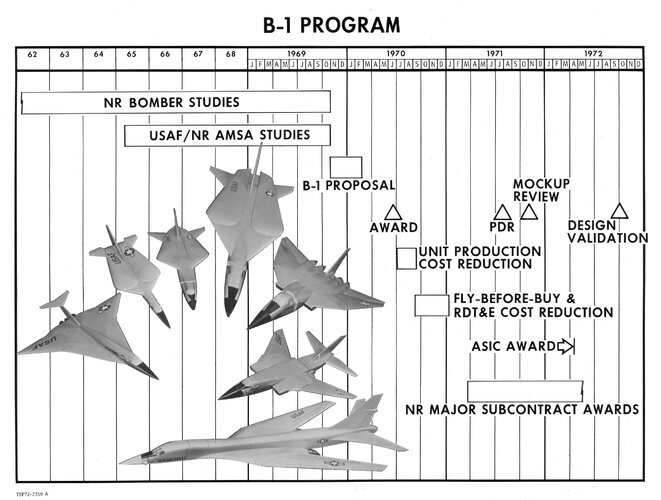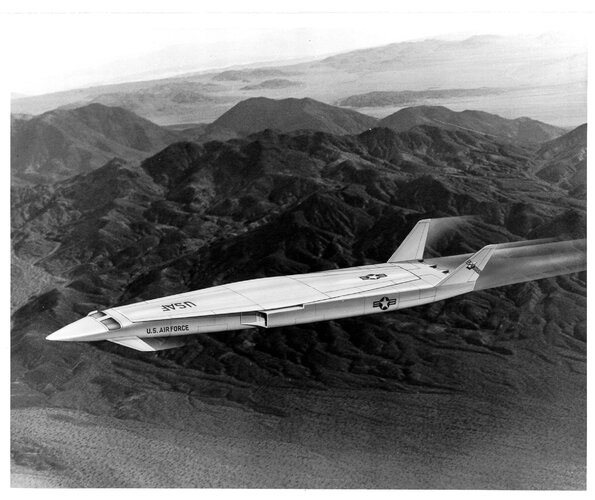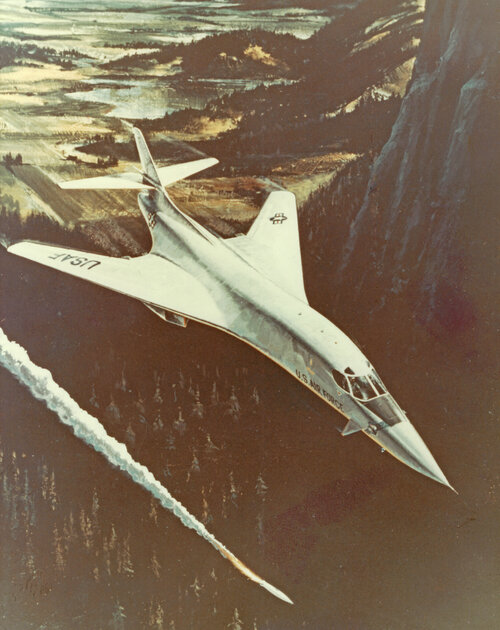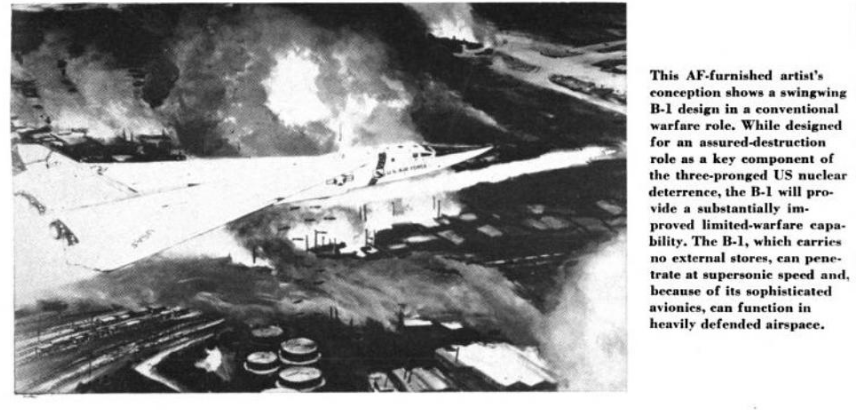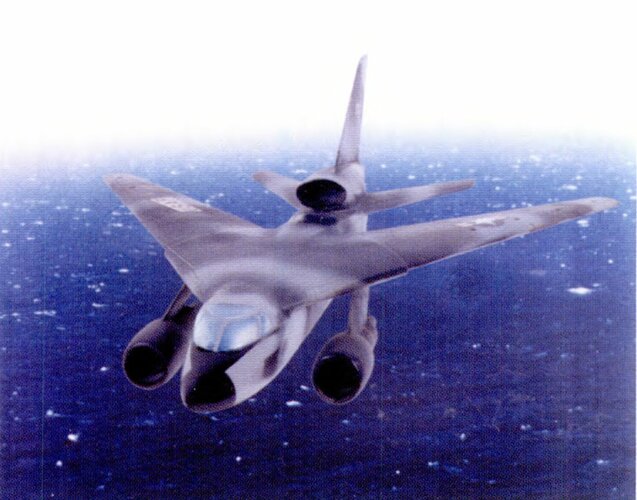You are using an out of date browser. It may not display this or other websites correctly.
You should upgrade or use an alternative browser.
You should upgrade or use an alternative browser.
AMSA Program & B-1 Bomber projects
sferrin said:That looks like a fighter canopy, not something you'd see on a bomber. ???
Well, B-47 and XB-52 had fighter-looking canopies too... and B-57, IIRC...
- Joined
- 26 September 2008
- Messages
- 1,960
- Reaction score
- 746
I'm trying to find info on the B-1 space launch vehicle proposal. It was a B-1 carrying a rocket with satellite underneath. I know I've seen it somewhere, possibly on this board, but I can no longer find it. Any help would be appreciated.
XP67_Moonbat
ACCESS: Top Secret
- Joined
- 16 January 2008
- Messages
- 2,271
- Reaction score
- 543
thefrecklepuny
ACCESS: Confidential
- Joined
- 19 January 2008
- Messages
- 123
- Reaction score
- 93
Was it to fly with its wings as swept back as that? A smooth ride at low level, yes. But also crash prone surely?
- Joined
- 27 December 2005
- Messages
- 17,748
- Reaction score
- 26,408
Nope, sweeping the wings all the way back to 90 degrees turning you to a lifting body was a 'thing' for a while. This model locates the pivots outboard to make it work.
- Joined
- 26 May 2006
- Messages
- 34,894
- Reaction score
- 15,759
My dear Flateric sent it before,but a clearer view;
 archive.aviationweek.com
archive.aviationweek.com
Aviation Week | Aviation Week Search results for: hiller
Search the complete Aviation Week archive. Explore every issue we have ever published: find every article, photo, story, interview, pictorial, advertisement, and more.
Attachments
- Joined
- 3 June 2011
- Messages
- 18,335
- Reaction score
- 12,233
PaulMM (Overscan) said:Nope, sweeping the wings all the way back to 90 degrees turning you to a lifting body was a 'thing' for a while. This model locates the pivots outboard to make it work.
I particularly liked the scissor-wing, low-altitude, lifting body bomber.
- Joined
- 9 October 2009
- Messages
- 21,969
- Reaction score
- 13,619
It rather belatedly occurred to me to copy this here.
Grey Havoc said:
- Joined
- 11 February 2007
- Messages
- 2,561
- Reaction score
- 4,360
TomS just pointed this one out from my verbal description in the oblique wing thread. There used to be a 1/48th scale (probably) model of this atop a cupboard in the flight controls office at BAE Systems Rochester. It had definitely been there since the GEC/GEC-Marconi Avionics days, and potentially all the way back to Elliott Avionics. It disappeared one weekend during some renovations (around about the millennium?) and hopefully it ended up in the Rochester Archives, not the skip, but I don't know.Also found at NTRS -timeframe (1966) suggest that it was LAMP-AMP-AMPSS program related. My previous thoughts of TFX were re-thought
Too late and unusual for TFX. Beat me if I'm wrong.
My recall, and obviously I haven't seen it in 20 years and even then it was atop an 8' cupboard, is that the wing, fuselage and tail matched the picture flateric posted, but that the nose was a horizontal flattened wedge. But after 20 years I could be wrong.
The existence of the model at Rochester does seem to imply that the project was advanced enough to be talking to potential systems sub-contractors.
- Joined
- 1 May 2007
- Messages
- 2,595
- Reaction score
- 1,965
This one perhaps ? The rightmost two images . . .
cheers,
Robin.
cheers,
Robin.
- Joined
- 11 February 2007
- Messages
- 2,561
- Reaction score
- 4,360
Yes. Absolutely that one. Glad to see my memory has stood the test of time!This one perhaps ? The rightmost two images . . .
cheers,
Robin.
- Joined
- 27 September 2006
- Messages
- 6,417
- Reaction score
- 6,815
My model that I got made of this designMy dear Flateric sent it before,but a clearer view;
Aviation Week | Aviation Week Search results for: hiller
Search the complete Aviation Week archive. Explore every issue we have ever published: find every article, photo, story, interview, pictorial, advertisement, and more.archive.aviationweek.com
Sentinel Chicken
American 71 Heavy, contact departure 126.47
I'd always wondered how much cross pollination there was between Boeing's AMSA work and the 2707 SST. Scott's line drawing bears a strong resemblance to the Model 733 design from about 1964 or so, but there was an AWST article from '65 or '66 that mentioned specifically that there was little commonality between the Boeing AMSA design and the SST program other than a variable sweep wing. The USAF stated that there was little to gain on AMSA from the SST flight test program as there was a need to have the AMSA design frozen well before the SST would make its maiden flight.
Interestingly the Boeing historical archives has material on a 1964 briefing on the SST given at SAC Headquarters in Omaha and a later 1966 briefing given to the Pentagon's Weapons System Evauation Group (WSEG).
Interestingly the Boeing historical archives has material on a 1964 briefing on the SST given at SAC Headquarters in Omaha and a later 1966 briefing given to the Pentagon's Weapons System Evauation Group (WSEG).
- Joined
- 27 September 2006
- Messages
- 6,417
- Reaction score
- 6,815
Hesham you may find this of interestFrom Пономарев А. - Авиация на пороге в космос - 1971.
- Joined
- 26 May 2006
- Messages
- 34,894
- Reaction score
- 15,759
Hesham you may find this of interest
https://www.secretprojects.co.uk/threads/amsa-initial-artwork-model.20856/
That's right my dear UK 75,it's fantastic Model
- Joined
- 26 May 2006
- Messages
- 34,894
- Reaction score
- 15,759
From Air Force 1991/2,
can we ID them all ?,did we do that before ?.
Attachments
- Joined
- 1 April 2006
- Messages
- 11,390
- Reaction score
- 10,276
asiscan
ACCESS: Confidential
- Joined
- 3 April 2014
- Messages
- 88
- Reaction score
- 89
Similar image from September 1967 Air Force/Space Digest magazine. Speculative artist's impression though no source given except the limited caption. Similar TAC/TFX VG wing.Advanced Manned Strategic Aircraft (AMSA) concept. Source does not specify manufacturer.
Source:
Авиация и Космонавтика 2005-11
crimso.msk.ru
Attachments
- Joined
- 11 March 2011
- Messages
- 307
- Reaction score
- 1,194
OK everyone.... here is one I just acquired. A General Dynamics AMSA proposal. Only needed a little paint touch up to make him all pretty. About 22 inches in length and of wood construction. Wings do their thing too...... enjoy.
Attachments
- Joined
- 13 June 2007
- Messages
- 2,173
- Reaction score
- 3,093
- Joined
- 3 June 2011
- Messages
- 18,335
- Reaction score
- 12,233
I have always liked that scissor-wing lifting body.Good Day All -
A few images from the Gerald Balzer collection to add to the thread.
Enjoy the Day! Mark
- Joined
- 27 September 2006
- Messages
- 6,417
- Reaction score
- 6,815
I had this model made for me a while back.OK everyone.... here is one I just acquired. A General Dynamics AMSA proposal. Only needed a little paint touch up to make him all pretty. About 22 inches in length and of wood construction. Wings do their thing too...... enjoy.
- Joined
- 9 October 2009
- Messages
- 21,969
- Reaction score
- 13,619
- Joined
- 27 December 2005
- Messages
- 17,748
- Reaction score
- 26,408
D
Deleted member 2278
Guest
Interesting! Seems to have some B-66 DNA from that angle.
- Joined
- 27 December 2005
- Messages
- 17,748
- Reaction score
- 26,408
North American AMSA design took some inspiration from this I think?
Thing looks like the lovechild of an S-3 Viking and the XB-51.
Great big high bypass turbofans. Yeah, I question how well those are going to stuff past the sound barrier.
Similar threads
-
-
-
1970s Boeing Advanced Bomber Studies
- Started by Sundog
- Replies: 112
-
North American 'Retaliator' & NR-349 Interceptor proposals
- Started by Pioneer
- Replies: 79
-

